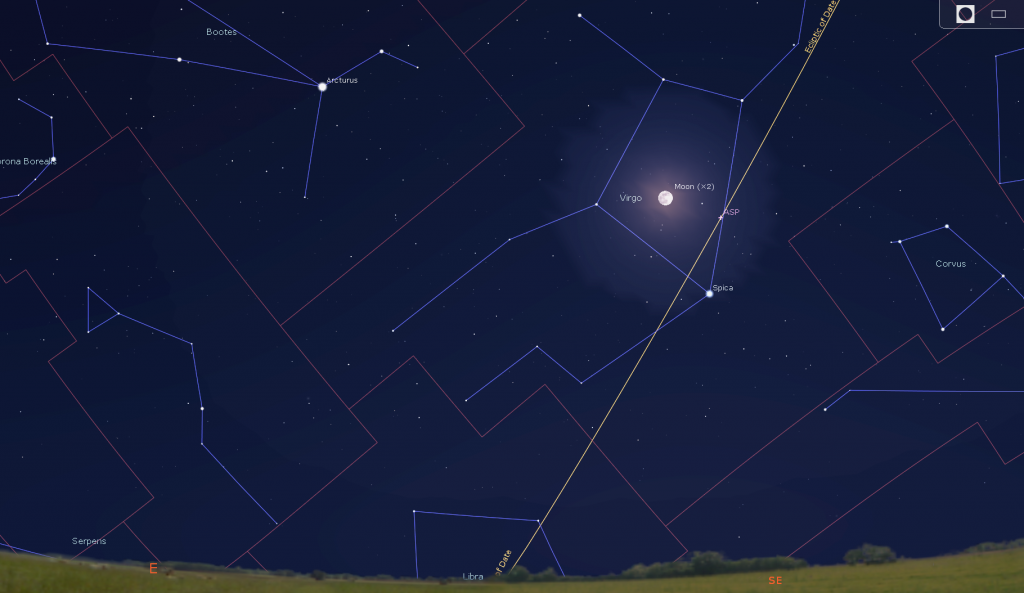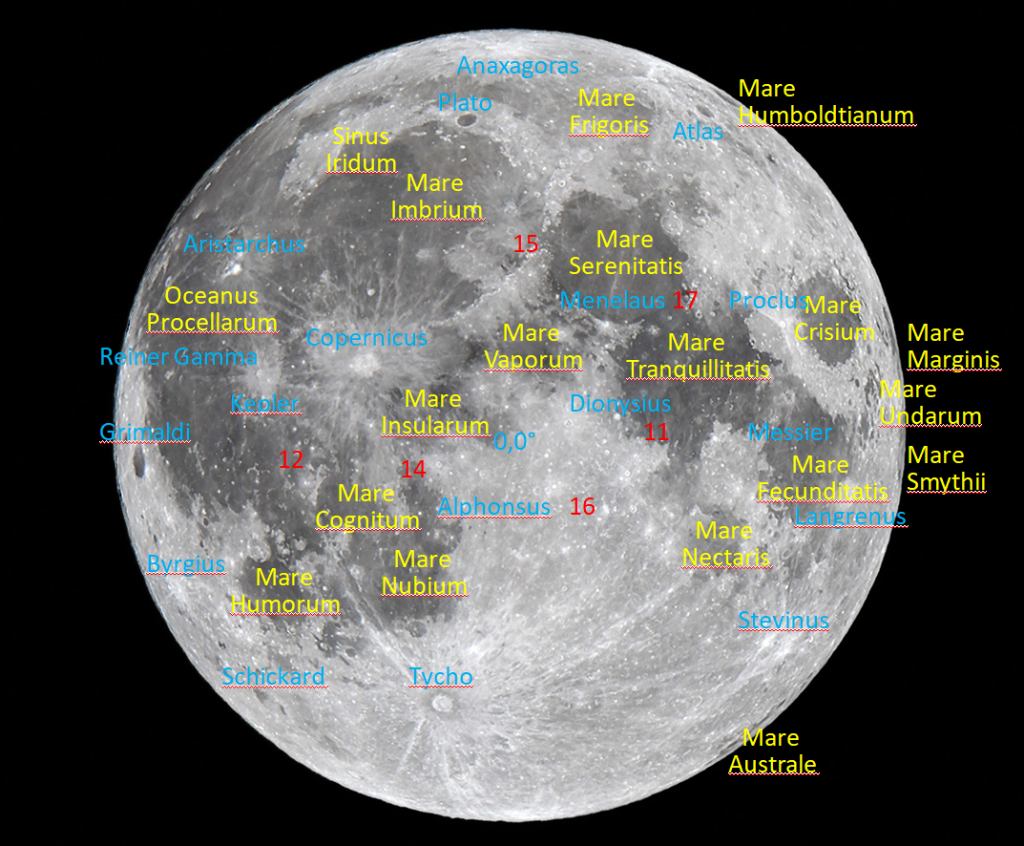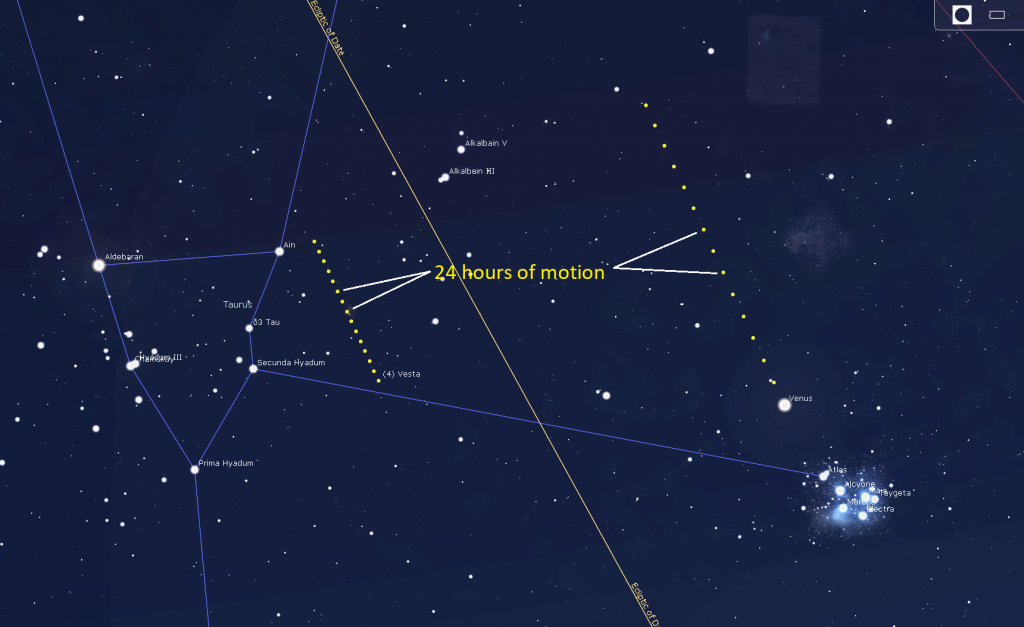The Full Pink Moon is Super, Vesta Rides near Venus, and Afternoon Astronomy Online Week Two!

This colour image of the full moon was taken in the UK by Simon Smith on August 31, 2012. It clearly shows the contrast between the dark lunar maria basalts, the white cratered highlands, and the ray systems extending from many recent impacts. Note the blue tint of titanium-enriched basalt in Mare Tranquilitatis (right of centre), where humans first stepped on the lunar surface. NASA APOD For September 1, 2012
Hello, Supermoon Stargazers!
Here are your Astronomy Skylights for the week of April 5th, 2020 by Chris Vaughan. Feel free to send me your comments, questions, and suggested topics. You can also follow me on Twitter as @astrogeoguy! Unless otherwise noted, all times are expressed in Eastern Time. To receive Skylights by email, please click this MailChimp link.
I can bring my Digital Starlab portable inflatable planetarium to your school or other daytime or evening event, or we can meet up online. Contact me through AstroGeo.ca, and we’ll tour the Universe together!
A full supermoon will shine in the night-time sky around the world on Tuesday night. I point out several interesting features of the full moon. Bright Venus will sit above the Pleiades star cluster in the western evening sky, not too far from the asteroid Vesta. Three bright planets are gathered in the pre-dawn southeast. Here are your Skylights!
Hey! Ben Brame of Toronto was able to record a video of the International Space Station flying across the disk of the moon on Saturday night! Here’s a link to his YouTube video if it. Wow!
The Full Pink SuperMoon
The April full moon will officially occur on Tuesday night at 10:35 pm Eastern Daylight Time zone (which corresponds to Wednesday at 02:35 Greenwich Mean Time). At full, the moon always rises around sunset and sets around sunrise because it is opposite the sun. The April full moon always shines in or near the stars of Virgo (the Maiden), which is half the sky away from the sun’s current location among the stars of Pisces (the Fishes). This full moon will occur less than 9 hours after perigee, the point in the moon’s orbit when it is closest to Earth. That will generate high tides worldwide, and will make this the second of three consecutive supermoons in 2020, and the largest one. The moon will appear about 8% brighter and slightly larger than average.

Every culture around the world has developed its own set of stories for the moon, and every month’s full moon now has one or more nick-names. The indigenous Ojibwe groups of the Great Lakes region call the April full moon Iskigamizige-giizis “Maple Sap Boiling Moon” or Namebine-giizis, the “Sucker Moon”. For them it signifies a time to learn cleansing and healing ways. The Cree of North America call it Niskipisim, the “the Goose Moon” – the time when the geese return with spring. The Cherokee call it Kawonuhi, the “the Flower Moon”, when the plants bloom. For Europeans, it is commonly called the Pink Moon, Sprouting Grass Moon, Egg Moon, or Fish Moon – terms that reflect the changes in the natural environment at this time of year. The moon will not look Pink!
When you turn and face the full moon, the sunlight striking the moon is coming from the direction behind your head – the same way the projector behind you in a cinema lights up the movie screen in front of you. Since that sunlight is arriving straight-on to the moon’s surface, it can’t generate any apparent shadows. Every variation in brightness and colour you see on a full moon is due entirely to the moon’s geology, and not its topography! At full, you can easily distinguish the dark, grey basalt rocks from the bright, white, aluminum-rich anorthosite rocks.
The basalts overlay the lunar maria (“MAH-ree-ah”). That Latin word for “seas” was coined because people used to think the moon’s dark features were water-filled. (The singular form of the word is mare.) The maria are basins that were excavated by major impactors early in the moon’s geologic history. Late in the moon’s geological history, those basins were filled in by dark basaltic rock that erupted from the interior of the moon. Nearly all of the moon’s maria are found on the hemisphere that permanently faces Earth. When it first formed, the moon likely spun faster on its axis, like the Earth still does. But the Earth’s continuous gravitational tidal force on the moon eventually slowed the moon’s rotation to the point where it keeps the same hemisphere pointed towards Earth now. Those tides always pulling on the same part of the moon probably caused the eruptions to favour the Earth-facing side.
The much older and brighter parts of the moon are composed of anorthosite rock. Those areas are higher in elevation and are heavily cratered – because there is no wind and water, or plate tectonics, to erase the scars of impacts. By the way, the bright, white appearance is produced by sunlight reflecting off of the crystals the rock is made of – the same sort of shiny crystals you see in the granite countertops in Earth’s kitchens. And yes, there are coloured rocks on the moon.

Some of the violent impacts that created the craters in the highland regions also threw bright streams of ejected material far outward and onto the darker maria. We call those streaks lunar rays. Some rays are thousands of km in length – like the ones from the very bright Tycho crater, which is located in the moon’s southern central region.
On the nights when the moon is full, or close to it, use your binoculars to scan around the moon. There are smaller ray systems everywhere! There are also places where craters etched into the maria have ejected dark rays on to white rocks. And, since the dark basalt overlays the white, older rock below, you can find lots of craters where a hole has been punched through the dark rock, producing a white-bottomed crater! By the way, the brightest spots on the moon are the youngest, geologically speaking. They are easy to see if you think to look for them.
Several of the maria link together to form a curving chain across the northern half of the moon’s near-side. Mare Tranquillitatis, where humankind first walked upon the moon, is the large, round mare in the centre of the chain. Sharp-eyes might detect that this mare is darker and bluer in colour than the others, due to enrichment in the mineral titanium. That’s one of the reasons why Apollo 11 was sent there.
Astronomical Easter, Pesach (Passover), and Ramadan!
Easter Sunday and Pesach (Passover) have an astronomical connection to the full moon, with the Jewish Passover pre-dating the Christian Easter. Some believe that the full moon’s light allowed for safer travelling by religious pilgrims of the time.
Tuesday’s full moon will be followed by the beginning of Passover – and by Good Friday and Easter Sunday on the coming weekend.
In 325 AD the Council of Nicaea determined that Easter should be observed on the Sunday following the first full moon that occurs after the vernal equinox, officially known as the Paschal Full Moon. The council fixed the equinox at March 21, but the astronomical timing of the equinox actually varies a little bit, and even occurs a full day early on Leap Years. This year, the equinox took place on March 19 at 10:50 pm EDT, and this is the first full moon to occur since then.
If the post-equinox full moon falls on a Sunday, the following Sunday becomes Easter. The earliest that Easter can ever occur is March 22, which last happened in 1818, and won’t happen again until 2285! If a full moon happens before March 21, Easter will be delayed by a full lunar month, plus up to six days. Such a late-April Easter will next happen in 2038.
Passover is celebrated from the 15th through the 22nd of the Hebrew month of Nissan in the Jewish lunar calendar. This year Passover will begin at sundown on Wednesday night, since the full moon will occur in Israel at 5:35 am on Wednesday. In years when the post-equinox full moon occurs early, Jewish religious leaders will delay Passover by a month to ensure that spring-like weather conditions (warmer temperatures and flowers in bloom) have arrived in Israel. The earliest that Passover can occur in our Gregorian Calendar is March 25, which will next happen in 2089.
In Western Christianity, Easter sometimes precedes Passover by several weeks. The Eastern Orthodox Church uses the older Julian Calendar, which schedules Easter using the precise moment of the astronomical equinox and full moon as measured in Jerusalem (where the crucifixion and resurrection occurred). This ensures that Easter always occurs after Passover, since Jesus had traveled to Jerusalem to observe Passover. This year, Orthodox Easter will be observed on Sunday, April 19.
The timing of Ramadan, the holiest month of the Islamic lunar calendar, is also linked to the post-equinox full moon. Ramadan begins when the crescent moon first re-appears in the western evening sky after the new moon phase that follows this full moon. With the next new moon occurring on Wednesday, April 22 at 10:26 pm EDT, that crescent should be apparent after sunset on the following day.
The Moon and Planets
Tonight (Sunday) the waxing gibbous moon will sit a generous palm’s width to the right (or 8.5 degrees to the celestial southwest) of the medium-bright, white star Denebola, which marks the tail of Leo (the Lion).
After its full phase on Tuesday night, the moon will begin to wane. It will rise more than an hour later every night – so viewing the moon a night or two before full is more convenient than afterwards. When the moon rises at 11:30 pm local time on Friday night, it will be dancing past the three little stars that mark the pincers of Scorpius (the Scorpion) – with the bright red star Aldebaran sitting a palm’s width below it. That moon will also remain in sight in the southwestern sky after sunrise, and on Sunday morning, too.

If you missed seeing Venus sitting inside the bright little Pleiades Star Cluster (also known as Messier 45 and the Seven Sisters) on Friday night, the very bright planet will still be situated just above the cluster as this week begins – ideal for viewing in binoculars. Every night, the combined effects of Earth’s and Venus’ motions will lift Venus farther above (east of) the cluster. But, in actuality, Venus will be slowly descending the western sky – in the closing stages of a very long evening appearance. It’s been there since September!
On any clear night this week, Venus will pop out of the twilight sky at dusk, and then set in the west at about midnight in your local time zone. If you want to see Venus’ less-than-fully-illuminated disk, aim your telescope at the planet as soon as you can pick it out of the darkening sky. In a twilit sky, Venus’ out-of-round shape will be more apparent. And, when Venus is higher in the sky you’ll be viewing the planet more clearly – through less of Earth’s distorting atmosphere.
As a bonus, the main belt asteroid Vesta will be traveling in a parallel path with Venus. It’s close to the triangle of stars that form the face of Taurus (the Bull). The magnitude 8.4 object can be seen in backyard telescopes. Look for it a generous palm’s width to the left (or 7 degrees to the celestial south) of Venus.

Early risers can continue to delight in seeing three bright planets gathered in low the southeastern sky between 4 am local time and dawn. The fun begins after 3:30 am in your local time zone. That’s when very bright, white Jupiter will rise. Medium-bright, yellowish Saturn will rise 20 minutes after Jupiter – and medium-bright, reddish Mars follows 15 minutes later. Once they climb a little higher, the trio will be nicely visible against a dark sky until about 6:30 am. After that, Mars and Saturn will be lost in the dawn twilight, but Jupiter will remain visible until sunrise.
Look for the Teapot-shaped constellation of Sagittarius (the Archer) sitting a fist’s diameter to the right (or celestial west) of Jupiter. Saturn and Mars will be sitting among the dim stars of Capricornus (the Sea-Goat).
Here are a few more interesting tidbits about the morning planets. For several mornings centred on Sunday, April 5, Jupiter will pass less than a finger’s width above (or 0.75 degrees to the celestial north) of Pluto – but that magnitude 14.32 planet cannot be seen with ordinary backyard telescopes. In the Eastern time zone, Jupiter’s Great Red Spot will be in view on Monday morning, Thursday morning, and Saturday morning. In the coming weeks, Mars’ faster orbital motion will be rapidly carrying it eastward away from the other two planets.

I’m LiveStreaming Astronomy for Families
Last week, I began hosting a series of free, one-hour, live daytime astronomy broadcasts geared towards families – in partnership with the Royal Astronomical Society of Canada. Jenna Hinds of RASC National acts as my co-host. She coordinates things behind the scenes and passes your Zoom and YouTube questions to me. You’ll love her energy!
During Session One we learned how to install and set up Stellarium – a fantastic and 100% free astronomy program that I use to prepare my Skylights every week. We ended the session by sharing a set of Astro-Scavenger Hunt questions that you can find here. Re-watch that video here: https://www.youtube.com/watch?v=qgME5ZogPS0, and then tackle the scavenger hunt.
On Thursday, we revealed the scavenger hunt answers in a fun and informative way, and then talked about viewing the night sky – with your unaided eyes, binoculars, or telescopes. That video is here: https://www.youtube.com/watch?v=tA7qbANBx9Q
The one-hour sessions will continue this week, on Tuesday and Thursday at 3:30 pm EDT, complete with new questions for Mission Two. You still have time to watch the first two videos before joining the fun. More information, the schedule, and the Zoom link to sign up are all here. If we reach Zoom’s capacity of 500 viewers, you can watch the sessions on the RASC’s YouTube channel in real time, or later on.
We hope to “see” you there!
Public Astro-Themed Events
Due to the COVID-19 virus, public star parties and lectures have been cancelled or postponed for the moment. Here are some alternate astro-themed activities.
Many astronomers are running broadcasts of the views through cameras attached to their telescopes while they describe the item and take questions. A search for the terms “star party” on YouTube and FaceBook should let you find live or recorded ones.
The RASC Toronto Centre has an archive of their past meetings and guest lectures on their YouTube Channel here.
The Canadian organization Discover the Universe is offering daily astronomy broadcasts for students called Astro at Home. Their website is here, and their YouTube channel is here.
On many evenings, the University of Toronto’s Dunlap Institute is delivering live broadcasts called Cosmos from Your Couch. The streams can be watched live, or later on their YouTube channel here.
The Perimeter Institute in Waterloo, Ontario has a library of videos from their past public lectures.
Keep looking up, and enjoy the sky when you do. I love questions and requests. Send me some!